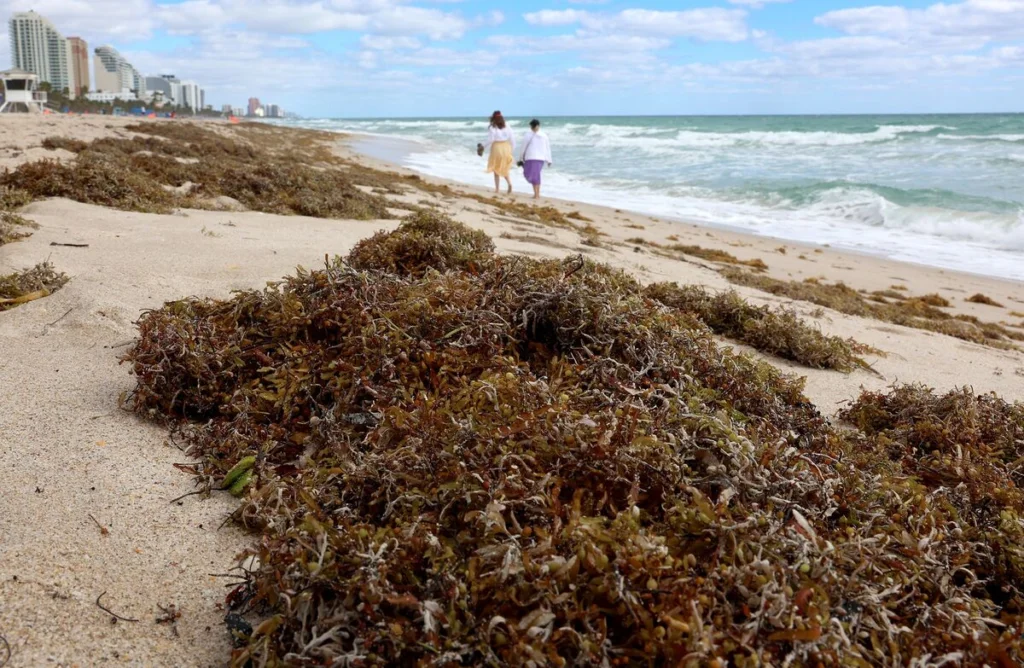Florida is once again bracing for a massive invasion of toxic seaweed, officially known as sargassum. Experts say that tons of this brown, smelly algae are slowly drifting toward the state’s eastern coastline, posing risks to marine life, local tourism, and public health.
This year’s bloom is one of the largest recorded, and scientists warn that the impacts could be severe. The floating seaweed mats stretch across thousands of miles in the Atlantic Ocean and are expected to make landfall in late May to early June, depending on ocean currents and wind direction.
What Is Sargassum and Why Is It Toxic?
Sargassum is a type of floating brown seaweed that naturally occurs in the Sargasso Sea, located in the middle of the North Atlantic Ocean. While it plays a beneficial role in the open ocean by providing habitat for fish, turtles, and birds, problems begin when too much of it piles up on the shore.

When sargassum washes ashore and begins to rot, it releases hydrogen sulfide gas, a toxic chemical that smells like rotten eggs. This gas can cause headaches, breathing issues, and irritation of the eyes, nose, and throat in humans. For people with asthma or other respiratory conditions, the effects can be worse.
According to the National Oceanic and Atmospheric Administration (NOAA), recent satellite images show a large bloom of sargassum floating in the Caribbean Sea and moving steadily toward Florida’s east coast.
Environmental and Economic Risks
The environmental impacts of a seaweed invasion can be devastating. As sargassum builds up on beaches and in shallow waters, it blocks sunlight from reaching seagrass beds and coral reefs. This reduces oxygen levels in the water, which can lead to fish kills and harm other marine species.
In 2023, when a similar mass reached Florida, marine biologists reported high mortality rates in young fish and sea turtles.
Beyond environmental damage, the economic consequences could be major. Florida’s tourism industry is still recovering from the effects of hurricanes and red tide blooms. Now, the looming seaweed crisis threatens beach access, water quality, and the state’s image as a beach paradise.
According to the Florida Department of Environmental Protection, cleaning up the seaweed can cost millions of dollars, especially in tourist hotspots like Miami, Fort Lauderdale, and the Florida Keys.
Local Communities on High Alert
Residents and local governments in coastal areas are already preparing for the worst. Beach maintenance teams are being deployed to set up containment barriers, dig out clogged drainage systems, and arrange for large-scale removal equipment.

In Miami-Dade County, officials are working with marine scientists to monitor the bloom and issue public warnings. The city of Fort Lauderdale has also set up an emergency hotline for beachgoers to report excessive sargassum buildup and any health symptoms caused by exposure.
One local beachgoer in Palm Beach shared, “Last year, the smell was unbearable. We couldn’t even sit outside. I really hope they clean it up faster this time.”
What’s Causing the Surge in Seaweed?
Several factors are fueling the increase in sargassum blooms over recent years. Experts point to climate change, rising ocean temperatures, and nutrient pollution from fertilizers and sewage as key reasons behind the explosive growth.
Runoff from rivers in South America, particularly the Amazon, carries fertilizers into the Atlantic, providing nutrients that feed the algae. Warmer waters and ocean current changes have also made it easier for the seaweed to grow and travel farther north.
A recent report by the University of South Florida’s Optical Oceanography Lab shows a sharp increase in sargassum in satellite data from January to April 2025, with projections indicating more is on the way.
Health and Safety Tips for the Public
While sargassum itself is not poisonous to touch, the gases released during decomposition can be harmful, especially for children, the elderly, and people with health issues.
Here are a few health and safety tips for residents and tourists:
- Avoid walking near large piles of rotting seaweed
- Stay indoors or wear masks if the smell is strong
- Close windows and doors near affected areas
- Report symptoms like headaches or breathing issues to a doctor
If you notice large patches of seaweed while swimming or boating, it’s best to avoid them as they can entangle propellers and pose safety risks.
What’s Being Done to Solve the Problem?
Researchers and government agencies are exploring several ways to deal with the growing seaweed crisis. These include:
- Floating barriers in open water to divert the seaweed before it reaches the shore
- Using the seaweed as compost or biofuel after safe removal
- Investing in early detection technologies to predict future blooms
Despite these efforts, experts caution that no long-term solution exists yet. Coastal communities will need to adapt and prepare for recurring events in the future.
Final Thoughts
The arrival of tons of toxic seaweed on Florida’s coastline is a reminder of how climate change and pollution are affecting our oceans. While state officials and researchers work on solutions, it’s important for residents and visitors to stay informed and take precautions.
To learn more about the causes and dangers of sargassum, you can visit the NOAA’s Sargassum Watch System.
As Florida waits to see the full impact of this massive bloom, the message is clear: our coastlines are on the front lines of a growing environmental crisis.
Also Read – Massive Greer Fire Destroys 9,500 Acres in Apache County





